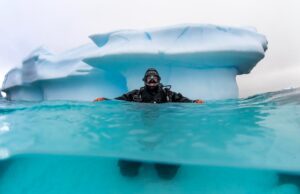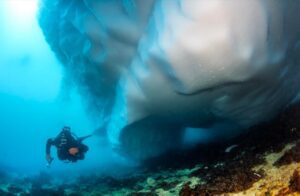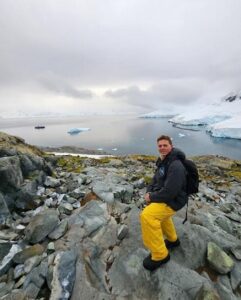John Humphreys had never seen snow in person until he ventured to Buffalo, New York in January — to scuba dive. Just a month later, the 15-year-old Tampa resident and 4-H member was navigating underwater around Antarctic icebergs.
Now back from his nearly three-week journey, John plans to spend most of his summer analyzing iceberg-related data he and 15 adult citizen scientists collected while under his instruction. His ability to convey what he learned through a research paper and two presentations in August will ultimately determine whether he earns certification as a MasterNaut, the highest distinction within the SCUBAnauts marine science education program.
 “The reason he went on this trip was to help answer some major questions and to let people know that kids can do it: that if you work hard enough toward something, you can achieve your goal, and he did,” said Nicole Humphreys, John’s mom.
“The reason he went on this trip was to help answer some major questions and to let people know that kids can do it: that if you work hard enough toward something, you can achieve your goal, and he did,” said Nicole Humphreys, John’s mom.
John’s ascent to potential MasterNaut status began in 2020, when he joined 4-H. Fellow members of the organization introduced him to scuba diving, and he became a SCUBA-naut, eventually earning certifications in advanced open water, rescue and coral restoration diving before reaching the master scuba diver classification, the highest recreational certification level.
 In October, he learned about a research trip to Antarctica scheduled to coincide with the 150th anniversary of the HMS Challenger’s 1874 crossing in the vicinity.
In October, he learned about a research trip to Antarctica scheduled to coincide with the 150th anniversary of the HMS Challenger’s 1874 crossing in the vicinity.
“Since the HMS Challenger made so many contributions to understanding our oceans, this trip was to commemorate the ship’s efforts and contributions and bring a new era of citizen science together,” John said.
The organizers of the trip approved the Central Florida teen’s request to join them in November. He quickly set about acquiring a drysuit capable of insulating his body against freezing water and achieved drysuit certification. Subsequent training for Antarctica required 50 dives, 10 of which took place within water of 39 degrees or below.
Katie Cooper, John’s SCUBAnauts instructor, accompanied him on the trip. She described him as “an incredibly determined young man.”
“When he first expressed interest, I had reservations because it is a very specialized activity that requires extensive preparation, even beyond the training and experience he already had,” Cooper said. “But the more we talked about it, we developed a plan, and I knew he would put his all into getting ready.”
Their ship, the 300-foot Ortelius, left Ushuaia, Argentina, on February 21st. Diving into 32-degree waters, John and his team classified the icebergs they encountered, documenting their shape, color and size. While aboard, he participated in a livestreamed informational video for elementary school students around the world. John and Amy Moran, a marine biologist at the University of Hawai’i at Manoa, showed viewers their extensive gear and described the wildlife they had observed on the trip: whales, leopard seals, sea spiders, sea anemones, plankton, limpets, sea stars and three species of penguins.
 “You’re the youngest person I know of who has ever dived in the Antarctic,” Moran told John during the livestream.
“You’re the youngest person I know of who has ever dived in the Antarctic,” Moran told John during the livestream.
A lofty accomplishment, sure, but it pales in comparison to John’s ultimate aspiration of becoming a mission commander astronaut specializing in Mars exploration.
“My hope is to help others reach for their goals and dream big because even something that sounds as impossible as diving in Antarctica at 15 is not if you have the drive to do it,” John said. “You just have to know it’s possible.”
Photo credits Becky Schott of Liquid Productions, Becky Schott of Liquid Productions, and John Humphreys


